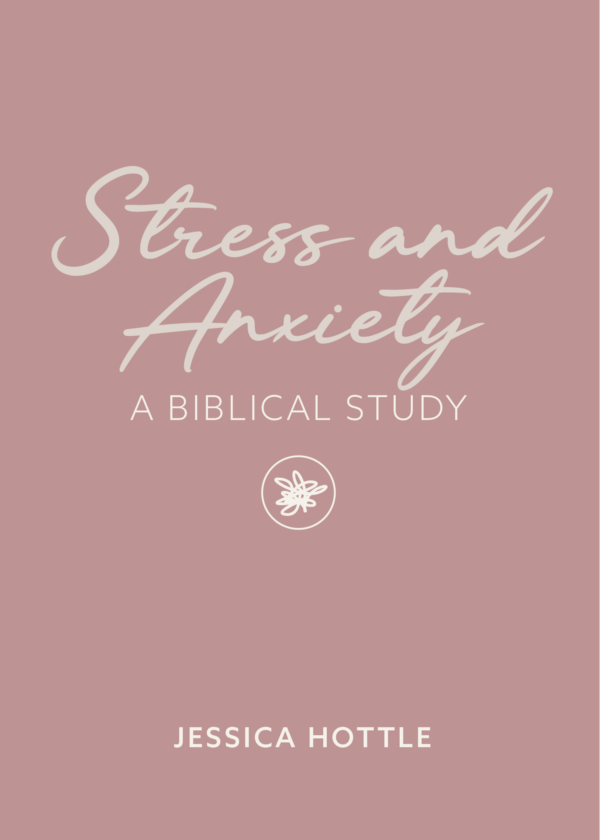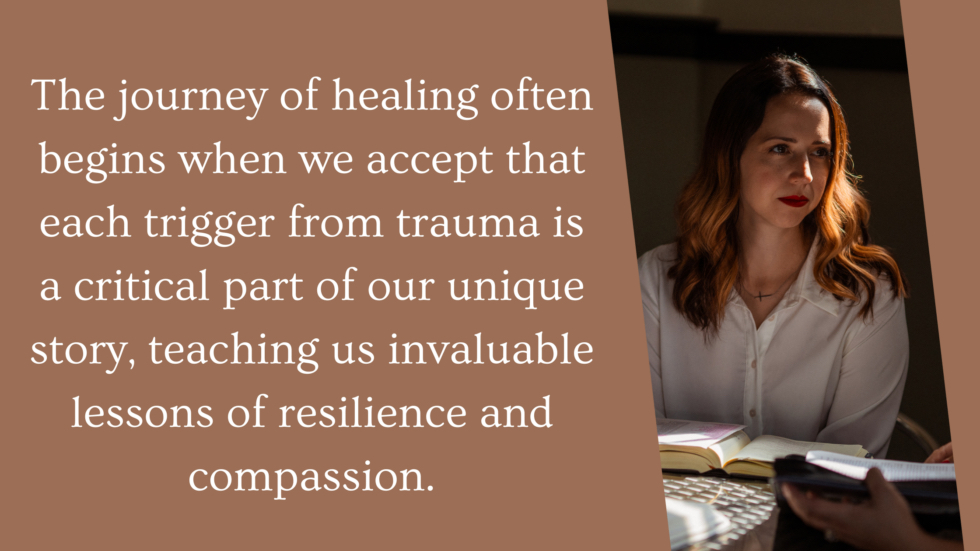There is no escaping the fact that we will experience pain or trauma triggers in this world. I like to say that the depth that we love is also the depth that we feel pain.
Love opens our hearts and welcomes the possibility of what could be and what is.
I spent years relearning what love was, knowing that it wasn’t abuse or manipulation. I had to experience a God who wasn’t about “give and take” like the love that I knew which was I did something for you so you need to do something for me.
I was skeptical. How could God choose me, and why would He?
Although God doesn’t cause the pain, living with fallen humans, we know that we aren’t going to get it right.
We will have pain, hurt, and experience trauma. Identifying and acknowledging our pain points will help us learn how to deal with triggers from trauma.
By the way, what if I told you your feelings aren’t inherently bad or sinful? You don’t need to fear or suppress them. They can be a guide. If you’re interested, I have a free 3-day study on living by faith while processing emotions. Check it out here!
Understanding the Role of a Trigger from Trauma in Emotional Healing
There is also emotional trauma which is the end result of events or experiences that leave us feeling unsafe and often helpless in the situation. It can result from a single event or be part of an ongoing experience, such as chronic abuse, bullying, discrimination or humiliation. Understanding that every trigger from trauma is a chance for growth and reflection can serve as a beacon of hope during challenging times.
We can also read about Big T traumas and Little T traumas.
Big T Trauma is generally related to a life-threatening event or situation. This could be a natural disaster, a violent crime, a school shooting, or a serious car accident. In addition, acute psychological traumas, such as the death of a parent, are part of the big T trauma definition.
Little t trauma refers to events that typically don’t involve violence or disaster but do create significant distress. For example, small trauma might be a breakup, the death of a pet, losing a job, getting bullied, or being rejected by a friend group. While these incidents don’t threaten physical safety.
For me, I want to be cautious to label everything we experience as trauma (and trauma triggers). When people disagree with us, when we get offended, upset at our co-workers, or in a fight with a friend, we are having life experiences where we have to work through conflict.
However, the realization that we are not defined by the trigger from trauma can initiate a powerful journey of healing and transformation.
(When our feelings are hurt, it’s not always a trauma, and we should be careful to label them appropriately.)
We have responses from our pain, based on trauma triggers, and our bodies will respond accordingly.
However, this is what I want you to know God’s love for you is not on trial. He wants to walk through this healing with you as you become more like Him.
He is the same yesterday, today, and forever. (Hebrews 13:8) He’s not changing His mind about you. Each time we confront a trigger from trauma with patience and understanding, we provide a chance for our inner wounds to heal.
*Learn about dealing with any guilt here!
Recognizing Your Trigger from Trauma: A First Step Towards Healing
What starts to happen is our feelings go unchecked and out of submission, and our wounds are left bleeding, hindering our ability to receive God’s grace and mercy in our lives. Trauma triggers can form from situations we don’t bring before God.
We start to think and eventually believe, “I’m not good enough for God. I made too many mistakes. Why would He want to love me? How could He forgive me?”
The good news is that His love, grace, and mercy have nothing to do with what you did or didn’t do. You didn’t go to the cross for your sins. Jesus did. That means that what you do or don’t do now, still has no effect on His affection towards you.
You can’t change what you didn’t start.
I want to break down why acknowledging what we know (logic and truth), and our relationships (emotional) must be in balance with each other to experience the fullness of God and to heal our trauma triggers.
Our brains have two sides: left and right. The right side is where we feel a connection, relational components, identity and worth, emotional expression, nonverbal communication through the body, and imagination, to name a few.
Our left brain focuses on logic, critical thinking, reasoning, conscious thought, and speech.
Each side works together at the same time. However, one side of our brain tends to guide us more than the other—the logical side or the emotional side.
Trying to build a relationship through works is why I believe so many of us have a hard time living out the truth we read in the pages of our Bibles. And restoring the brokenness (trauma triggers), we feel versus receiving forgiveness through repentance.
The good news is that God doesn’t care about how much we know or do in His name; He wants to know if we know Him. Acknowledging a trigger from trauma isn’t a sign of weakness, but rather a courageous step toward reclaiming our narrative and fostering our healing.
Matthew 7:21–23 paints a clear picture of this for us:
Not everyone who says to Me, “Lord, Lord,” shall enter the kingdom of heaven, but he who does the will of My Father in heaven. Many will say to Me in that day, “Lord, Lord, have we not prophesied in Your name, cast out demons in Your name, and done many wonders in Your name?” And then I will declare to them, “I never knew you; depart from Me, you who practice lawlessness!”
The context of this scripture is that He is closing out His Sermon on the Mount by sharing a final warning about true faith. Jesus is reminding us that people will use all the right words, but they will not belong to the Lord. Jesus was not talking about knowledge in this scripture. He was talking about relationships.
God created us for relationship with Him.
Biblical Study on Stress and Anxiety eBook
$5 Are you stuck in a cycle of stress and anxiety, wondering if there’s a way to break free and find peace that lasts? Embark on a transformative journey from feeling anxious and stressed to living with peace and freedom. This biblical study offers an insightful exploration of stress and anxiety, providing practical tools to…
A New Perspective: Seeing Your Trigger from Trauma as an Opportunity for Growth
Emotional pain left unchecked loops in the emotional side of the brain, disconnecting from the part of the brain that conducts reasoning and cognitive (conscious thinking) processing. The reasonable part of the brain is unable to help the emotionally loaded part of the brain get away from the pain.
When we experience pain, trauma (creating trauma triggers), and sin, adrenaline rushes through the body, and the memory is imprinted into the amygdala (which holds the emotional significance of the event, including the intensity and impulse of emotion), which is part of the limbic system (the part of the brain involved in our behavioral and emotional responses, especially when it comes to behaviors we need for survival).
For example, if you’re on a roller coaster, your sensory information is “fear, speed, stress, excitement, not life-threatening.” The amygdala can read the emotional significance of the event as it’s a fun ride that you’ll be off in three minutes.
The memories are stored through fragments of visual images, smells, sounds, tastes, or touch. (Why scripture also tells us to not live carnally – to live carnally is to live by our five senses.)
Engaging the body and the mind in the recovery process is crucial, especially when healing from trauma triggers. This is where faith and works draw parallel. It’s not about our works, but our faith is completed by our works. People see what we do. Our actions should support our faith.
The journey of healing often begins when we accept that each trigger from trauma is a critical part of our unique story, teaching us invaluable lessons of resilience and compassion.
The Stages of Trauma
Experiencing trauma can lead to various emotional, psychological, and physical responses. While the specific cycle and intensity of each stage can vary from person to person, here is a general outline of the common stages individuals may go through when experiencing trauma:
Impact: The initial stage involves the traumatic event itself, such as a natural disaster, accident, abuse, or loss. This event disrupts one’s sense of safety, security, and well-being.
Denial and Shock: Immediately after the traumatic event, individuals may experience shock, disbelief, or denial as a defense mechanism. It can be challenging to fully grasp the reality and magnitude of what has occurred.
Emotional Response: Intense emotions often emerge during this stage, such as fear, anger, sadness, guilt, shame, or confusion. These emotions may be overwhelming and may fluctuate rapidly.
Intrusive Memories and Flashbacks: Recurrent and intrusive thoughts, memories, or nightmares related to the traumatic event can occur. Flashbacks, where individuals feel as if they are reliving the trauma, can be distressing and trigger intense emotions.
Avoidance and Numbing: To cope with the overwhelming emotions and memories, individuals may try to avoid reminders of the trauma. This can involve avoiding certain places, people, activities, or even suppressing emotions altogether. Numbing oneself to emotions and feeling detached from others is also common.
Hyperarousal and Hypervigilance: Individuals may experience heightened sensitivity, irritability, restlessness, or difficulty sleeping. They may be constantly on guard, hypervigilant to potential threats, or easily startled.
Negative Self-Perception: Trauma can significantly impact one’s self-image and self-worth. Individuals may develop feelings of guilt, shame, or self-blame, leading to a negative perception of themselves.
Social and Interpersonal Challenges: Trauma can strain relationships and social interactions. Individuals may withdraw from others, experience difficulty trusting or forming new relationships, or struggle with communication and emotional intimacy.
Reintegration and Healing: With time, support, and appropriate coping mechanisms, individuals can begin to reintegrate their experience into their lives. This stage involves seeking professional help, engaging in self-care practices, and gradually rebuilding a sense of safety, trust, and resilience.
Strategies to Begin to Heal from Trauma
Healing from trauma triggers is a complex and individualized process.
Here are some strategies that can help in the healing journey:
Seek professional help: Consider working with a therapist or counselor who specializes in trauma. They can provide guidance, support, and evidence-based therapies like Cognitive-Behavioral Therapy (CBT), Eye Movement Desensitization and Reprocessing (EMDR), or Trauma-Focused Therapy to help you navigate and heal from trauma triggers.
Understand your triggers: Take time to identify your specific triggers and how they affect you. This self-awareness can help you anticipate and manage them more effectively. Explore the emotions, memories, and sensations that arise when triggered to gain a deeper understanding of your responses.
Develop grounding techniques: Grounding techniques can help bring you back to the present moment when triggered. Examples include deep breathing exercises, mindfulness practices, focusing on sensory experiences (e.g., touch, smell, taste), or using grounding objects like a stress ball or a favorite item that provides comfort.
Create a safety plan: Establishing a safety plan can be helpful in managing triggers. Identify strategies to ensure your physical and emotional safety during triggering situations. This may involve setting boundaries, establishing support systems, or removing yourself from triggering environments when necessary.
Practice self-care: Engage in activities that nurture your well-being and promote self-care. This can include exercise, spending time in nature, practicing relaxation techniques, journaling, pursuing hobbies, or engaging in creative outlets. Prioritize self-care as a regular part of your routine.
Build a support network: Surround yourself with a supportive network of friends, family, or support groups who can provide understanding, empathy, and encouragement. Sharing your experiences with others who have gone through similar challenges can foster a sense of connection and validation.
Develop coping strategies: Explore healthy coping mechanisms to manage triggers when they arise. This might include deep breathing exercises, progressive muscle relaxation, engaging in calming activities, practicing self-compassion, or using affirmations or mantras to ground yourself.
Challenge negative beliefs: Trauma can lead to negative beliefs about yourself, others, or the world. Work on challenging and reframing these beliefs through therapy or self-reflection. Replace self-blame or self-criticism with self-compassion and a more balanced perspective.
Practice gradual exposure: With the guidance of a therapist, consider gradually exposing yourself to triggers in a controlled and safe manner. This can help desensitize you over time and reduce the intensity of the triggering response. However, only engage in exposure therapy when you feel ready and supported.
Be patient and kind to yourself: Healing from trauma takes time and patience. Recognize that it’s a gradual process, and there may be ups and downs along the way. Be gentle with yourself and celebrate small victories and progress made, no matter how small they may seem.
In every trigger from trauma, there’s an invitation to explore our strength and embrace the journey of healing with God.
Resources for Learning about Triggers from Trauma
*Some of these links are affiliate links. This means I receive a small commission when you use a couple of these links, which goes back to my ministry.






